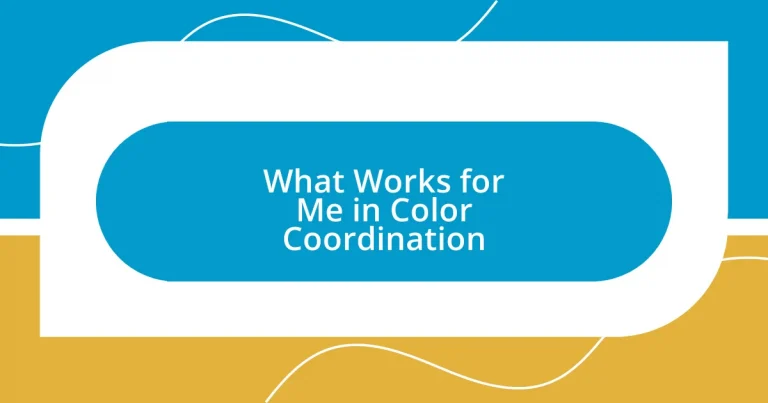Key takeaways:
- Color theory impacts emotions and mood; colors can create different atmospheres in personal spaces.
- Choosing a color palette with a limited number of shades enhances visual harmony and avoids overwhelming designs.
- Personalizing color selections fosters a connection to memories and emotions, making spaces reflect individual identity and feelings.

Understanding Color Theory
Color theory is more than just mixing hues; it’s a fascinating exploration of the emotional and psychological impacts colors can have on us. For example, I remember when I painted my office a soft blue. It immediately created a calm atmosphere that helped me focus better on my work. Have you ever noticed how certain colors can shift your mood?
Understanding color harmonies—like complementary or analogous colors—plays a crucial role in creating visually appealing designs. I once attended an art workshop where we experimented with these harmonies, and it was eye-opening to see how the right combinations could evoke different feelings. It makes me wonder: how can we all use this knowledge to enhance our personal spaces?
Furthermore, cultural perceptions of color are equally important. For instance, in some cultures, white symbolizes purity, while in others, it represents mourning. When I traveled abroad, witnessing these diverse interpretations added an extra layer of appreciation for how color can carry such weighty significance. It reminds me that every choice we make in color coordination can tell a unique story.

Choosing a Color Palette
Choosing a color palette can be both exciting and daunting. I remember when I redecorated my living room. I spent hours exploring shades and swatches, trying to find the right combination that would feel warm yet sophisticated. It’s amazing how a simple choice can transform a space and reflect your personality, don’t you think?
One helpful tip I’ve found is to limit your palette to three or four colors. This approach not only maintains harmony but also helps avoid overwhelming your senses. On my recent project, I decided on a deep green, warm beige, and crisp white. As I painted, I felt a sense of peace wash over me, knowing that simplicity can often lead to unexpected beauty.
When selecting colors, consider the lighting in your space. Natural light can change the way colors appear at different times of the day. I learned this the hard way when I painted a bold orange in a poorly lit room. Instead of energizing, it felt oppressive and cramped. Always test samples in various lighting conditions to ensure your chosen palette truly enhances the ambiance you desire.
| Color Choice | Emotional Impact |
|---|---|
| Soft Blue | Calming and Focused |
| Deep Green | Balanced and Restorative |
| Bold Orange | Energetic, but can feel Overwhelming |
| Warm Beige | Cozy and Inviting |
| Crisp White | Clean and Fresh |

Combining Colors Effectively
Combining colors effectively is an art that can transform any space or outfit. Last summer, I decided to experiment with combining pink and green for a vibrant outdoor gathering. Using a soft blush pink alongside a deep forest green not only created a fresh look but also brought a sense of balance through contrast. This experience taught me that contrasting colors can be just as powerful as those that blend harmoniously.
Here are some tips I’ve picked up along the way:
- Start with a dominant color: Choose one color to act as the main visual focus. For instance, in my garden, I used a bright yellow to draw the eye.
- Add neutrals: Incorporating neutral shades like gray or white can ground your color choices. I often use beige or taupe to soften more vibrant hues.
- Experiment with patterns: Combining colors through patterns can add depth. During one of my painting projects, I used striped fabric in my patio arrangement, mixing a sunny yellow with a calming green.
- Trust your instincts: Go with your gut feeling when choosing colors. I once neglected my intuition and ended up with a dull brown instead of the lively coral I initially loved.
- Use nature for inspiration: Nature offers a brilliant color palette. I still take my best color cues from the sunsets I watch outside my window, blending oranges, pinks, and purples beautifully.
With every color combination, it’s crucial to pause and reflect on how it makes you feel. I’ve found that my best outcomes come from a mix of thoughtful planning and spontaneous choices. Each color brings its own personality, and together they can create something truly unique.

Creating Visual Balance
Creating visual balance in a space or design is like orchestrating a symphony. I remember the first time I rearranged my home office. I added a vibrant teal desk and paired it with soft, golden accents. The contrast felt invigorating yet calming, offering a perfect balance between energetic creativity and a tranquil workspace. Isn’t it fascinating how the right mix can influence our mood and productivity?
I’ve come to realize that visual balance often hinges on weight distribution among colors and elements. For example, placing a large, bold piece of art on one wall can make the space feel off-balance if there’s nothing substantial on the opposite side. I once balanced a large canvas with a group of smaller framed photos. The symmetry worked harmoniously, creating an inviting atmosphere that encouraged me to spend hours there, immersed in my projects.
Another aspect I find crucial is considering the texture of colors. Incorporating different textures adds depth and richness, making the visual experience even more engaging. When I styled my living room, I mixed plush velvet cushions with sleek cotton throws in complementary colors. This combination didn’t just create balance; it brought a tactile element that invited people to sit down and stay awhile. Have you ever noticed how a space changes when textures play a role in the color scheme? It’s amazing how it can transform an ordinary room into a cozy retreat.

Incorporating Trends and Styles
Incorporating trends and styles can be both exciting and daunting. I recall attending a fashion event last spring, where pastel shades were all the rage. I decided to embrace this trend by layering different pastel tones—soft lilac with buttery yellow. The refreshingly playful look transformed my usual style and sparked conversations wherever I went. Isn’t it remarkable how a simple trend can help reveal a different side of our personalities?
I’ve learned that it’s essential to keep an eye on the seasons when aligning with trends. Enhancing my home decor during autumn, I leaned into rich, warm colors like burnt orange and deep burgundy, which not only aligned with the seasonal vibe but also created the cozy atmosphere I craved. Engaging with these colors made my living space feel like a welcoming hug, drawing in friends for warm gatherings. How much do seasonal shifts influence your color experiences?
Another powerful way to incorporate styles is to mix old with new. I remember thrifting a vintage chair upholstered in a bold geometric print and placing it next to my sleek, modern sofa. The contrast was delightful! It evoked a sense of nostalgia while simultaneously giving a nod to contemporary design. Have you ever considered how blending styles can create a rich narrative in your own spaces? The stories we tell through color and design can be incredibly personal, making every choice meaningful.

Applying Color Coordination in Design
Applying color coordination in design can feel both intricate and rewarding. I vividly recall my experience with designing a small café space; I chose a deep navy for the walls to create an intimate feel. The addition of warm copper accents not only illuminated the room but also generated an inviting atmosphere that made customers feel at home. Have you ever transformed a space simply by adjusting the colors and viewing angles? It’s almost magical what a little thoughtfulness around color can do.
When working with color, I often find that creating a cohesive palette can significantly enhance the overall design. I experimented once with a monochromatic scheme for my bedroom, using varying shades of green alongside subtle white accents. The monochromatic effect fostered a soothing environment that encouraged relaxation, making it my favorite retreat. Isn’t it interesting how choosing shades within the same color family can impact the mood of a space so profoundly?
Practical application of color coordination also thrives on engaging contrasts. One time, I designed an outdoor patio and opted for a vibrant orange table set against lush green plants. The bold choice drew the eye and created a playful vibe, sparking joyful conversations during gatherings. Have you tried contrasting colors in your outdoor spaces? It’s remarkable how such choices can breathe life into an area and invite a sense of energy and excitement.

Personalizing Color Selections
Personalizing color selections is an intimate journey that reflects who we are. I once decided to paint my office in a vivid teal, a shade that reminds me of my childhood days spent by the ocean. Every time I sit down to work, the color sparks inspiration and creativity, almost like a gentle reminder of that carefree spirit. Have you ever chosen a color because it evokes a cherished memory?
In my experience, mixing colors from various palettes can lead to some truly unique results. I fondly recall when I combined earthy terracotta with soft blush in my kitchen. This unexpected pairing created a warm and inviting vibe, making the space feel like a hug while I cooked. It’s fascinating how personalized combinations can speak volumes about our tastes and preferences.
Color selections also resonate with our emotions and moods. When I’m feeling particularly introspective, I gravitate towards calming shades of blue and gray in my living room. These colors help create a tranquil retreat, fostering a sense of peace amidst the chaos. What emotions do your chosen colors evoke in your everyday life? It’s worth reflecting on how our color choices connect with our deeper selves.














